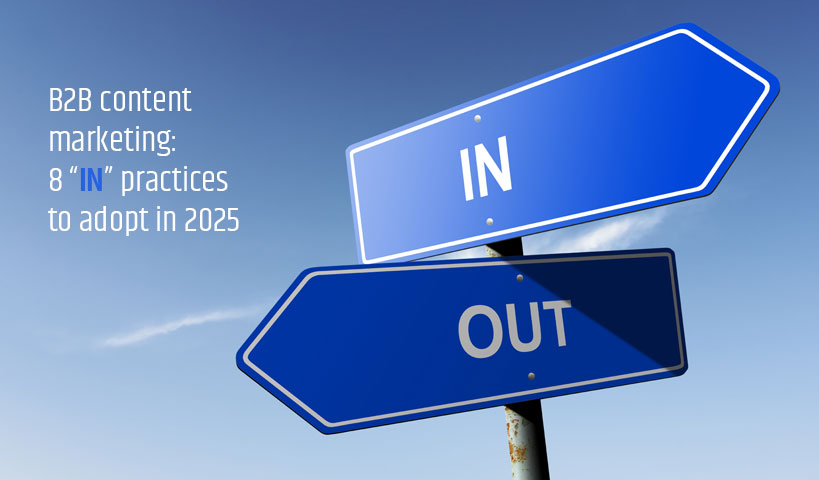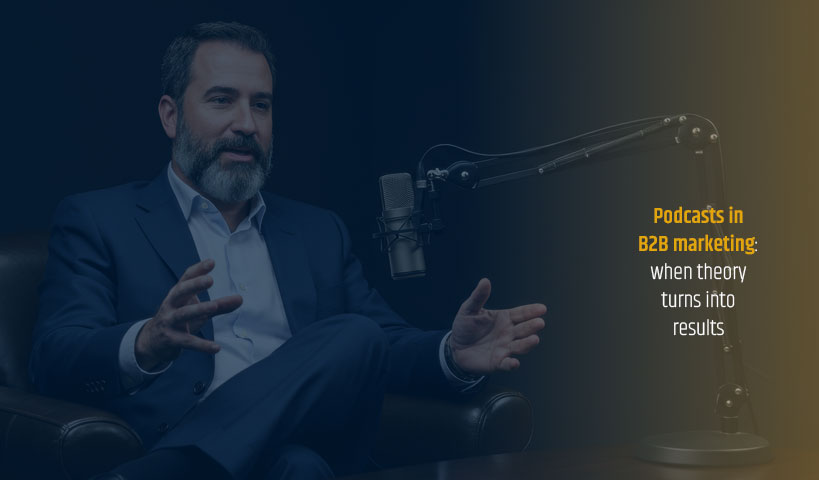
Happy New Year to all! What better way to kick off 2025 than with a roundup of the best practices that will shape B2B content marketing this year? So, inspired by Ann Handley’s recent newsletter on “IN & OUT” practices, we’ve explored the industry’s leading approaches. And identified what we absolutely must put forward in 2025… and leave behind in 2024.
She believes that by 2025, B2B content marketing will evolve towards greater authenticity, depth and human relationships. In other words, generic content will give way to more sincere messages and creative strategies designed to create impact over time.
Let’s move on to the not-so-serious, but essential things for you at the start of the new year. So, what will be “IN” and “OUT” in B2B content marketing in 2025?
✅ B2B content marketing practices to adopt (IN) :
1. Craft and thoughtful creativity
Gone are the days of mass-produced publications. Basically, the brands that will stand out in 2025 will have favored carefully crafted, personalized texts aligned with their identity. In other words, creative consistency becomes key: harmonized visuals, a consistent tone of voice and a strong editorial signature ensure instant recognition.
Example: a Quebec-based technology company specializing in human resources management solutions could produce a series of educational videos. In this way, it explains how to optimize talent management in the local context. And it does so with clear visual illustrations and a narrative style adapted to Quebec’s cultural realities.
2. Emotion in B2B content marketing
Rational marketing alone is no longer enough. Even in technical sectors, buying decisions are influenced by emotional connections. Telling human, engaging stories is becoming essential to creating a lasting bond.
3. First-party data in B2B content marketing
Gone are the days of massive, impersonal data collection. The truth is, first-party data (newsletters, voluntary forms, event registrations and qualitative data mining) outperforms data collected by third parties. Transparency and informed consent are essential.
For example, a professional services firm may offer an exclusive report on best practices in financial management. In reality, this would be in exchange for a voluntary subscription to their newsletter, with a clear policy on data use.
4. Data storytelling
Presenting numbers without context is no longer enough. In 2025, narrative data visualization turns facts into compelling stories. The aim: to make statistics meaningful and easy to remember. Instead of a simple performance-oriented table, tell the story of how a better campaign doubled results with a dynamic infographic.
For example, a digital marketing agency could publish an illustrated case study showing how an improved SEO strategy led to a 150% increase in organic traffic, in the form of a dynamic infographic. Talking, isn’t it?
5. True thought leadership
Today, companies that opt for B2B content marketing and want to be LEADERS in their field of expertise must assert leadership in front of their target audiences. And to do so, it can no longer rely solely on traditional tactics. It must develop a Thought Leadership strategy.
That’s why it’s so important to PLAN and establish a PRESENCE in social networks, and ENGAGE a relationship of trust based on the production of high-quality texts and publications to support its traditional offering, and an openness to socio-professional interaction.
Thought leadership is also characterized by the regular and sustained production of texts and analyses. No company can lay claim to it unless it is deeply rooted in its practice, organization and culture. This means investing resources in it and making the most of them in day-to-day management.
Example – A CEO of a manufacturing company could write a blog post himself, and not his marketing team. He would analyze the consequences of possible new tariffs and propose adaptation strategies specific to Canadian companies.
6. Building relationships, not just audiences
The emphasis is on loyalty rather than mass acquisition. By focusing on sincere interactions and initiatives such as discussion groups or exclusive platforms, as a B2B company you create a sense of belonging among your customers. These authentic relationships build trust and loyalty among your existing customers.
By maintaining an ongoing dialogue, you can also better identify your customers’ changing needs and adjust your offerings accordingly. This human-centered approach not only satisfies current expectations, but also paves the way for sustainable growth by attracting potential customers (prospects) seduced by your transparency and attentiveness.
7. Quality newsletters
Well thought-out newsletters remain a powerful channel. In 2025, they are personalized, engaging and offer real added value, far removed from the changing algorithms of social networks.
8. Lasting impact
Creating publications should no longer be limited to capturing immediate attention. In 2025, we value long-lasting publications that leave a lasting imprint.
In our world, information circulates at high speed. Trends change rapidly. As a company, you need to adopt a more thoughtful and strategic approach to your content marketing. It’s no longer just about attracting clicks. Or to generate ephemeral leads. But to produce resources that continue to bring value in the long term. They need to be designed to address known or recurring issues for your target audience, while remaining relevant in the face of changing market conditions.
An enduring publication, such as a detailed white paper, how-to guide or educational video series, acts as a long-term investment. What’s more, these types of resources promote better natural search engine optimization (SEO), attracting consistent, qualified traffic over a long period. This also reduces the need for costly, one-off advertising campaigns, as these resources continue to generate opportunities organically.
Last but not least, the enduring impact of B2B content marketing is based on loyalty. By offering resources that remain useful and accessible over time, you cultivate a relationship of trust with your current or potential customers. These resources serve as a point of reference, reinforcing the perception of your company as a reliable and visionary partner. In a B2B context, where decision-making cycles are often long, this strategy can make all the difference in setting you apart in a competitive market.

🚫 Practices to leave behind in B2B content marketing (OUT) :
So, let’s move on to the practices to be abandoned in 2025. We won’t go into lengthy descriptions or explanations, as these are practices to forget. Essentially, they’re good only for being mentioned and then…forgotten.
Mass AI-generated content
What particularly irritates me when I read posts or other texts published on blogs, sites or LinkedIn in recent months, is the abusive use of AI in copywriting. Please stop publishing in their entirety the fruit of proposals made to you by AIs such as Chat GPT and other Claudes of this intelligent but artificial world…
No one is fooled, and it shows like a big nose on your face. Excessive use of automatically generated content, often generic and soulless, is to be avoided. Humanity and personalization come first. Like what you’re reading right now. So a little rant here and there doesn’t hurt – on the contrary. It spices up the reading experience.
Anyway, let’s move on to the other OUT practices in B2B content marketing:
Ephemeral attention
The race for quick clicks and superficial views is losing ground. From now on, the priority is to really captivate, even a smaller audience.
Forced third-party tracking
With the end of third-party cookies, privacy and voluntary data collection become unavoidable standards.
Creative chaos
Mismatched visuals and constant changes of tone undermine brand recognition. Consequently, visual consistency is now essential.
AI-generated reviews
Fake testimonials and automated reviews lack credibility. In contrast, real, sincere reviews remain the most powerful.
Decisions made too quickly
Taking the time to analyze and structure your messages is becoming a strength. In this way, reflection replaces immediate reactivity.
Purely rational B2B content marketing
Factual discourse alone is no longer enough. Emotion and story must enrich the presentation of facts.
What this means for B2B content marketing in 2025
We’re at an important turning point in 2025. From now on, the industry will be moving away from ephemeral practices and approaches focused solely on immediate performance. The new norm will value publications that are thoughtful, sincere and geared towards building trusting relationships.
Imagine one of your customers discovering a series of content that resonates with their daily challenges and reinforces their trust in your expertise. This is where the power of thoughtful texts and publications lies.
You’ll need to rely on more human strategies, telling stories that resonate with your audience and engaging in real dialogue with your customers. This shift doesn’t mean abandoning data, but rather using it more ethically and transparently, which strengthens your brand’s credibility.
This refocusing on authenticity and quality represents a major opportunity. It enables you to stand out from the crowd in a saturated market, by focusing on content that leaves a lasting impact. Far from superficial tactics, the brands that succeed will be those capable of creating deep connections and truly inspiring trust.
So, by embracing these principles, B2B content marketing in 2025 will become more strategic, focused on value and rooted in building long-term relationships. Interested in exploring how these trends can apply to your business? Contact our experts today to find out how we can support you in this evolution.




